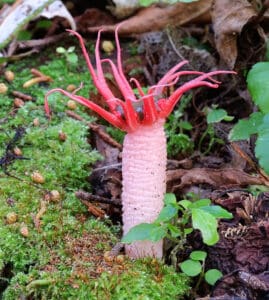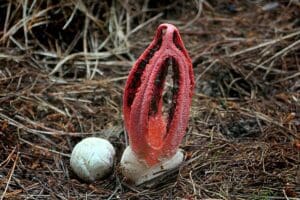Devils fingers / Summer / Autumn / Inedible
Scientific Name
Clathrus archeri
Common Names
Devils fingers, Octopus Stinkhorn
Family
Phallaceae
Known commonly as the Stinkhorns.
Habitat
Rare in the UK only appearing in southern areas, but its distribution is widespread over the globe. Preferring warmer tropical regions and Native to the southern hemisphere like Australia and New Zealand.
Saprophytic, found in areas with abundant decaying matter in moist areas such as leaf litter and bark chippings under vegetation like trees, shrubs and sometimes also in fields.
June- September in southern Britain and channel islands where its warmer.
Description
A magnificent find indeed! Smelling and looking like tentacles of rotting flesh, quite a spectacular and unusual fungi, easy to see how it’s earned its common name Devils fingers with its border line disturbing appearance, you could easily be excused for thinking you’d stumbled across a hatching alien egg!
Identifying Features
Fruiting body
The fruiting body grows in two distinct phases first forming an egg called a suberumpent egg.
The egg is off white to light brown, gelatinous, slimy and ball-like about 2-3cm.
Next the thallus emerges from the egg with 4-6 (typical) to 8( rarely) starfish/ octopus-like legs. Each leg can grow to 10cm. They emerge vertically then spread out horizontally making the total width about 20cm. The flesh is mostly bright red, with older gleba turning darker.
Stem
None
Pores/gills
Neither pores or gills, like other Phallaceae (Stinkhorns) Clathrus archeri produces a smelly sticky substance called gleba that houses the spores, this attracts insects like flies and beetles that will then spread the spores.
Spores
Olive brown
Smell
Unpleasant, like rotting flesh or dung attracting insects who then assist with spore dispersal.
Uses
In food
Beyond some weird initiation test, with its stench its unlikely anyone would remotely consider eating this, however its not actually been proven to be toxic but still all resources strongly recommended against consumption.
The egg stage of some Stinkhorns are eaten by the brave and curious but there is no record for the egg of devils fingers .
Medicinal Uses
None known
Harvesting
Being rare and not edible there’s no reason to disturbed it, so best left untouched.
Known hazards
Potentially toxic but unknown.
Potential lookalikes
Starfish Fungus (Aseroe rubra) very rare in Britain, similar but has a thicker stem and each tentacle is divided.

Extra Notes
Clathrus archeri produces compounds similar to the scent of rotting flesh. This compound production supports evidence of convergent evolution between fungi and angiosperms.
The generic name Clathrus means ‘a cage’, and although not too relevant to Devil’s Fingers it does seem entirely appropriate when applied to Clathrus ruber, the Red Cage Fungus, which is the type species in the same genus.
References
https://www.wildlifetrusts.org/wildlife-explorer/fungi/devils-fingers-fungus
https://www.first-nature.com/fungi/clathrus-archeri.php
https://en.wikipedia.org/wiki/Clathrus_archeri













